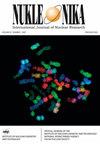能量分辨检测系统在乳腺X线摄影应用中的应用:初步研究
IF 0.3
4区 物理与天体物理
Q4 CHEMISTRY, INORGANIC & NUCLEAR
引用次数: 0
摘要
摘要癌症仍是癌症女性患者死亡的主要原因之一。这一事实在医学领域引起了火花,这反过来又有助于多年来改善癌症患者的诊断和治疗,使这一领域始终以新的想法和创新的方法活跃起来。在我们的研究中,探索了一种新的方法,使用由NaI(Tl)闪烁探测器制成的能量分辨检测系统来检测Am-241辐射源的伽马光子,试图通过扫描美国放射学会(ACR)乳房X光体模来构建图像。除了实验工作外,还使用了Geant4断层扫描发射应用程序(GATE)工具包来研究更复杂的选项,以提高乳房X射线照相系统的图像质量,这受到实验设置的限制。在实验设置中,研究人员能够使用26.3keV和59.5keV的能量光子构建图像,以显示ACR体模中最大尺寸的肿瘤(12mm)。随着模拟环境中设置的改进,大多数ACR体模肿瘤在26.3keV和59.5keV的两个能量窗口下都是可见的,其中26.3kev产生了更好质量的图像,显示了四个肿瘤,而在使用59.5kev时显示了三个。仿真结果是有希望的;然而,实验工作中需要进行一些改进,以便该系统能够生成与GATE模拟设置获得的图像类似的高分辨率乳房X光图像。本文章由计算机程序翻译,如有差异,请以英文原文为准。
Utilization of an energy-resolving detection system for mammography applications: A preliminary study
Abstract Breast cancer remains one of the major causes of mortality among female cancer patients. This fact caused a spark in the medical field, which in turn helped to improve the diagnostic and treatment of breast cancer patients over the years making this field always active with new ideas and innovative methods. In our study, a new method was explored using an energy-resolving detection system made from a NaI (Tl) scintillation detector to detect the gamma photons from an Am-241 radiation source to try and construct an image by scanning the American College of Radiology (ACR) mammography phantom. In addition to the experimental work, a Geant4 Application for Tomographic Emission (GATE) toolkit was used to investigate more complex options to improve the image quality of mammographic systems, which is limited by the experimental setup. From the experimental setup, the researchers were able to construct an image using the 26.3 keV and the 59.5 keV energy photons, to show the largest size tumour (12 mm) in the ACR phantom. With an improved setup in the simulation environment, the majority of the ACR phantom tumours was visible using both energy windows from the 26.3 keV and the 59.5 keV, where the 26.3 keV yielded better quality images showing four tumours compared to three when using 59.5 keV. The simulation results were promising; however, several improvements need to be incorporated into the experimental work so that the system can generate high-resolution mammographic images similar to the ones obtained by the GATE simulation setup.
求助全文
通过发布文献求助,成功后即可免费获取论文全文。
去求助
来源期刊

Nukleonika
物理-无机化学与核化学
CiteScore
2.00
自引率
0.00%
发文量
5
审稿时长
4-8 weeks
期刊介绍:
"Nukleonika" is an international peer-reviewed, scientific journal publishing original top quality papers on fundamental, experimental, applied and theoretical aspects of nuclear sciences.
The fields of research include:
radiochemistry, radiation measurements, application of radionuclides in various branches of science and technology, chemistry of f-block elements, radiation chemistry, radiation physics, activation analysis, nuclear medicine, radiobiology, radiation safety, nuclear industrial electronics, environmental protection, radioactive wastes, nuclear technologies in material and process engineering, radioisotope diagnostic methods of engineering objects, nuclear physics, nuclear reactors and nuclear power, reactor physics, nuclear safety, fuel cycle, reactor calculations, nuclear chemical engineering, nuclear fusion, plasma physics etc.
 求助内容:
求助内容: 应助结果提醒方式:
应助结果提醒方式:


